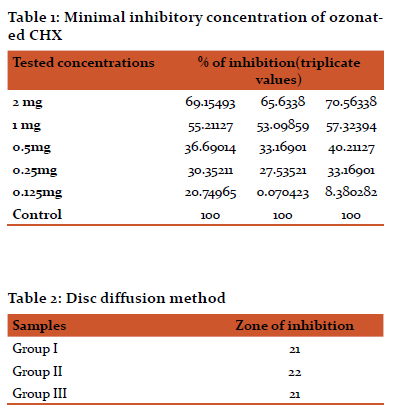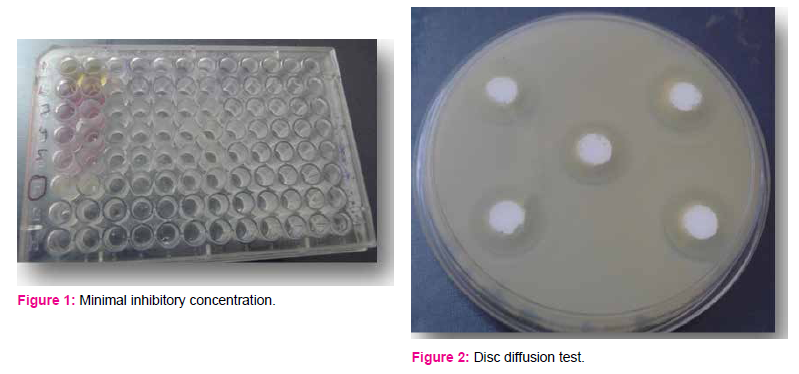IJCRR - 10(2), January, 2018
Pages: 16-18
Date of Publication: 19-Jan-2018
Print Article
Download XML Download PDF
Comparative Evaluation of the Antibacterial Activity of Calcium Hydroxide in Combination with
2% Chlorhexidine and Ozonated Chlorhexidine Against E.faecalis \? An Invitro Study
Author: Ravivarman C., Karthikeyan A., Senthilkumaran M., Josephin Shalini R.
Category: Healthcare
Abstract:Introduction: Calcium hydroxide has been used with various vehicles in the treatment modalities of Endodontics. Owing to the increased antibacterial resistance, Ozone is currently being discussed as a possible alternative vehicle because of its reported high antimicrobial property without the development of drug resistance.
Aim: The purpose of this study was to investigate and compare the effectiveness of calcium Hydroxide in combination with 2% chlorhexidine and ozonated chlorhexidine for elimination of E.faecalis bacteria.
Materials and Methods: In this study aqueous ozone was used, it was prepared by passing gaseous ozone through CHX in a glass beaker. Minimal inhibitory concentration of ozonated CHX was obtained by serial dilution method. The samples were assigned to 3 groups: Group I- Calcium hydroxide with saline; Group II- Calcium hydroxide with 2% Chlorhexidine; Group IIICalcium hydroxide with ozonated chlorhexidine. Efficacy of intracanal medicaments against E.faecalis was carried out by disc diffusion method. Results were statistically analysed by one way ANOVA.
Results: The antimicrobial effectiveness of the samples in Group II where ozone was ozonated with reduced percentage i.e. 0.12% was around 21mm which is almost equal to that of 2% CHX and the results were found to be statistically significant at 0.5.
Conclusion: Ozonated CHX with reduced concentration possessed similar antimicrobial effect as conventional CHX in combination with calcium hydroxide.
Keywords: Ozone, Chlorhexidine, Calcium hydroxide, Zone of inhibition
DOI: 10.7324/IJCRR.2018.1023
Full Text:
Introduction: The success of root canal treatment relieson biomechanical preparation, irrigation, microbial control and complete obturation of the root canal system. Bacteria and their products are considered the primary etiologic agents of pulp necrosis and peri-radicular lesions1. Due to anatomical complexities and consequent limitations of access by instruments and irrigants, microorganisms infecting the root canal may survive endodontic procedures.
Microorganisms may also infiltrate through a poor temporary seal during the period betweenappointments for endodontic treatment. Therefore, the use of a root canal dressing is important for obtaining and maintaining a disinfected canal after mechanical instrumentation and before root canal obturation. Despite of its viscous consistency, the paste made by mixing calcium hydroxide and chlorhexidine (CHX) gel 2% was found not to influence the sealing ability of the obturation technique. Calcium hydroxide plays an important role in endodontics due to its ability to induce hard tissue formation, its antibacterial effectand its ability to act as a physical barrier toprevent root canal reinfection2. In an attempt to enhance the anti-microbial activity of calcium hydroxide, different substances have been used as vehicles.
Chlorhexidine glucometer has been widely used as an endodontic irrigant, because of its wide antimicrobial activity against Gram-positive and Gram-negative microorganisms. CHX may also present residual antimicrobial activity on the dentin surface after prolonged with the root canal3. Studies have suggested that CHX could be used in combination with calcium hydroxideto improveantimicrobial efficacy against resistant microorganisms. However a meta- analysis conducted by Mastoid Saatchi concluded that mixing calcium hydroxide with CHX does not improve antibacterial property as intracanal medicament against E.feacalis.
Currently, ozone has beendiscussed as a possible alternative antiseptic agent in dentistry because of its reported high antimicrobial power without the development of drug resistance. Ozone gas in a concentration of 4g/m3(Heal Ozone; Kavo, Liberace, Germany) is already being used clinically for endodontic treatment4. Regarding the demand on relative non-toxicity toward periapical and oral mucosal tissue for the endodontic irrigants, the ozone gas concentration currently used in endodontics (4 g/ m3) has been shown to be slightly less cytotoxic than NaOCl (2.5%) and aqueous ozone (up to 20 μg/mL) showed essentially no toxicity to oral cells in vitro. Hence the purpose of the study is to compare the antibacterial effectiveness ozonated CHX in combination with Calcium hydroxide and that of calcium hydroxide in combination with 2%CHX.
Materials and methods:
Preparation of samples: In this study aqueous ozone was used, it was prepared by passing gaseous ozone through CHX in a glass beaker. As a preliminary step, the minimal inhibitory concentration of ozonated CHX was obtained by serial dilution method. The samples were assigned to 3 groups: Group I- Calcium hydroxide was mixed with saline; Group II- Calcium hydroxide was mixed with 2% Chlorhexidine; Group III- Calcium hydroxide was mixed with ozonated chlorhexidine.
Isolation of micro-organisms: Pure strain of Enterococcus faecalis from American type culture (ATCC #29212) was used. Respectively cultures were grown over-night at 37°C in brain heart infusion (BHI) broth on a rotary shaker 150 rpm and microbial growth were checked by changes in turbidity at 24 hours.
Antimicrobial activity testing: Antimicrobial efficacy of the assigned samples wastested against E.faecalis using agar disc diffusion method. Mueller-Hinton broth was selected and the plates were incubated at 37° C in bacteriological incubator for 48h. Wells of diameter 6mm and depth 3mm were made and the samples were subjected to antimicrobial testing.
Zone of inhibition: Samples were placed in the prepared wells and thediameter of inhibition areas of microbial growth was measured after 48h with a millimetrecalliper, for each sample, which corresponded to the substance’s antimicrobial potential.
Results: The antimicrobial effectiveness of the samples in Group II where ozone was ozonated with reduced percentage i.e. 0.12% was around 21mm which is almost equal to that of 2% CHX and the results were found to be statistically significant at 0.5.

Discussion: The success of root canal treatment lies in the complete elimination of microorganisms. E.faecalis is the most common microorganism present in the persistent per-radicular infection. Due to its versatile nature various medicaments have been tried to completely eliminate from root canals. And also owing to the increased antimicrobial resistance, alternatives to antibiotics have been tried5.
Ozone, due to its interesting biologic properties can be used to treat root canal infection with reduced antimicrobial resistance and side effects6. Ozonated oils with zinc oxide eugenol when used as root filling material in primary tooth had shown good success rate7. Chlorhexidine has been proved to be effective against E.faecalis and to improve its properties ozone can be incorporated.at the same time, a meta-analysis concluded that mixing of CHX with calcium hydroxidehas no additive effect8. In this study, ozonated chlorhexidine has been used in combination with calcium hydroxidefor elimination of E.faecalis. The samples were assigned to three groups and subjected to disc diffusion method for antimicrobial efficacy. After 48 hours the antimicrobial efficacy was evaluated by measuring the zone of inhibition. The antimicrobial efficacy of 0.12% ozonated CHX in combination with calcium hydroxidewas almost equal to that of 2% CHX with calcium hydroxide.
Conclusion:Since the cytotoxic effects of CHX has been found to be dose dependant, ozonated CHX with reduced percentage and with added effects of ozone seems to be a better alternative. However further clinical trials and randomized control studies have to be done to use it as an intracanal medicament invivo.

References:
- C. M. Sedgley, S. L. Lennan , O. K. Appelbe Survival of Enterococcus faecalis in root canals ex vivo. International Endodontic Journal. 2005; 38:735-42.
- Zerella JA, Fouad AF, Spangberg LSW, Effectiveness of a calcium hydroxide and chlorhexidine digluconate mixture as disinfectant during retreatment of failed endodontic cases. Oral Surg Oral Med Oral Pathol Oral Radiol Endod 2005;100:756-61.
- Zamany A, Safavi K, Spangberg LS. The effect of chlorhexidine as an endodontic disinfectant. Oral Surg Oral Med Oral Pathol Oral Radiol Endod. 2003;96(5):578-81.
- Baysan A, Lynch E. Effect of ozone on the oral microbiota and clinical severity of primary root caries. Am J Dent. 2004;17(1):56– 60.1
- Nagayoshi M, Kitamura C, Fukuizumi T, Nishihara T, Terashita M. Antimicrobial effect of ozonated water on bacteria invading dentinal tubules. J Endod. 2004;30(11):778–81.8.
- Estrela C, Estrela CR, Decurcio DA, Hollanda AC, Silva JA. Antimicrobial efficacy of ozonated water, gaseous ozone, sodium hypochlorite and chlorhexidine in infected human root canals. Int Endod J. 2007;40(2):85–93.
- Chandra SP, et al Success of root fillings with zinc oxide-ozonated oil in primary molars: preliminary results. Eur Arch Pediatr Dent 2014;15;191-5
- Masoud Saatchi, et al. antibacterial effect of calcium hydroxide combined with chlorhexidine on Enterococcus faecalis: a systematic review and meta-analysis. J Appl Oral Sci. 201;22(5):356-65.
|






 This work is licensed under a Creative Commons Attribution-NonCommercial 4.0 International License
This work is licensed under a Creative Commons Attribution-NonCommercial 4.0 International License